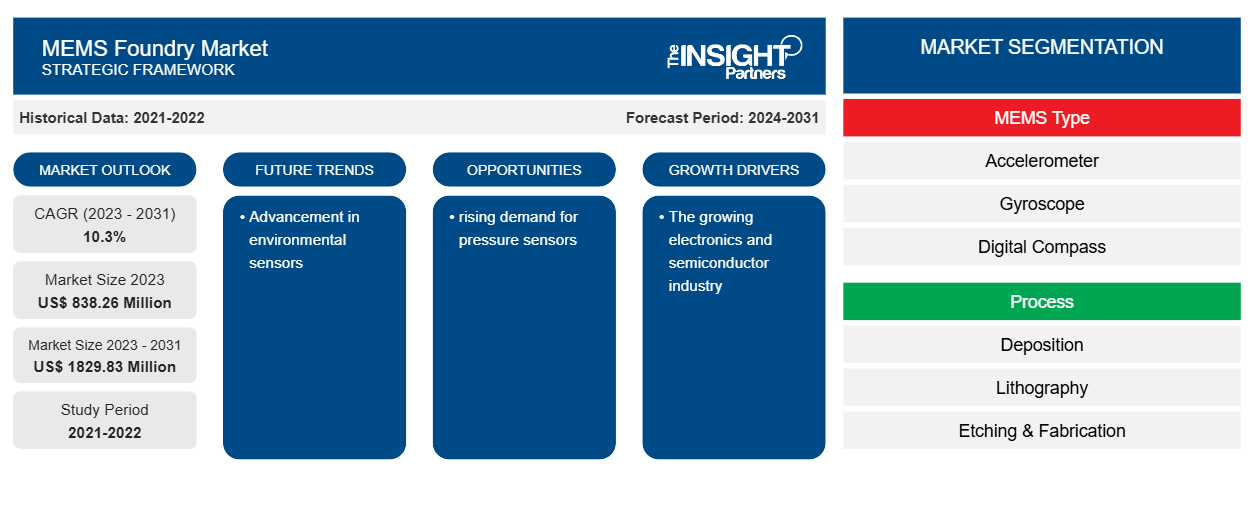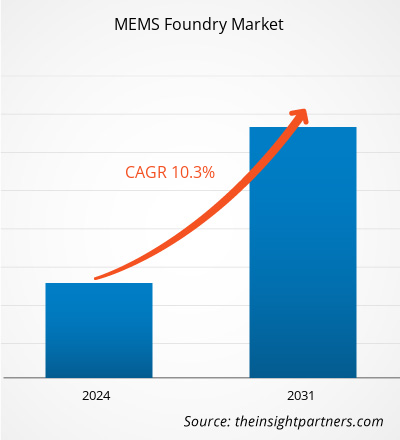The MEMS foundry market size is projected to reach US$ 1829.83 million by 2031 from US$ 838.26 million in 2023. The market is expected to register a CAGR of 10.3% during 2023–2031. The growing electronics and semiconductor industry and rising demand for pressure sensors are likely to remain key trends in the market.
MEMS Foundry Market Analysis
The rising number of consumer electronics and wearable devices is driving the market growth. The growing semiconductor industry is fueling the market growth further. The rise in the application of MEMS sensors in the defense sector fosters the market. The growing market for vehicles, robotics, equipment handling equipment, and others further drives the market.
MEMS Foundry Market Overview
MEMS foundry is a specialized manufacturing facility where MEMS design devices are designed and fabricated. These devices are small integrated systems that combine electrical and mechanical components that are used for sensors, actuators, micromotors, and other small components. They offer the flexibility to use substrate materials such as gallium arsenide (GaAs), silicon-on-insulator (SOI), quartz, glass, silicon, and complementary metal-oxide-semiconductor (CMOS)-wafers.
Customize This Report To Suit Your Requirement
You will get customization on any report - free of charge - including parts of this report, or country-level analysis, Excel Data pack, as well as avail great offers and discounts for start-ups & universities
MEMS Foundry Market: Strategic Insights

-
Get Top Key Market Trends of this report.This FREE sample will include data analysis, ranging from market trends to estimates and forecasts.
MEMS Foundry Market Drivers and Opportunities
Rise in the consumer electronic market
The growing consumer electronics market mainly drives the MEMS foundry market. Growing penetration of different types of consumer electronic devices such as tablets, computers, smartphones, electronic gadgets, home appliances, smart wearables, etc. Moreover, the demand for semiconductor chips has also been mainly driven by the consumer electronics sector across the world. The MEMS foundry is mostly engaged in the manufacturing of micro components for consumer electronics products only as they have a large volume of contracts for the same as well.
Demand for pressure sensor
Pressure sensors are used across a variety of applications, such as automotive, medical, building & construction, industrial, and aeronautics applications. The demand for MEMS foundry services for pressure sensor applications is mainly driven by the need for manufacturing chips & semiconductor components for developing pressure sensors. Further, some of the major applications that are driving the demand for MEMS foundry for pressure sensor applications.
Automotive: The automotive industry uses pressure sensors for a variety of applications, such as different types of power trains that include MAP, BAP, particle filters, fuel tank evaporation power trains, exhaust gas power trains, engines, and transmission oil power trains.
Medical: Medical applications of pressure sensors include blood monitoring of patients (invasive and non-invasive), respiratory systems, smart inhaler equipment, and other treatment equipment & systems that are used across hospitals and medical emergencies.
MEMS Foundry Market Report Segmentation Analysis
Key segments that contributed to the derivation of the MEMS foundry market analysis are the MEMS type, process, foundry type, and end user.
- Based on the MEMS type, the MEMS foundry market is divided into accelerometer, gyroscope, digital compass, MEMS microphone, pressure sensor, temperature sensor, and others. The accelerometer segment held the largest share of the market in 2023.
- By process, the market is segmented into deposition, lithography, etching & fabrication, and packaging. The commercial segment held a significant share of the market in 2023.
- By foundry type, the market is segmented into piezoelectric, electrostatic, ferroelectric, electromagnetic, and others. The piezoelectric segment held a significant share of the market in 2023.
- By application, the market is segmented into consumer electronics, automotive, industrial, healthcare, and others. The consumer electronics segment held the largest share of the market in 2023.
MEMS Foundry Market Share Analysis by Geography
The geographic scope of the MEMS foundry market report is mainly divided into five regions: North America, Asia Pacific, Europe, Middle East & Africa, and South & Central America.
Asia Pacific region is expected to grow with the highest CAGR. The growing electronics & semiconductor industry in the APAC countries is driving the adoption of MEMS sensors, which further supports the expansion of the MEMS foundry market. Moreover, the mass production of electronic devices such as wearables, smartphones, and TVs in Taiwan and China is anticipated to boost the demand for sensors, leading to the growth of the MEMS foundry market.
MEMS Foundry Market Regional Insights
The regional trends and factors influencing the MEMS Foundry Market throughout the forecast period have been thoroughly explained by the analysts at The Insight Partners. This section also discusses MEMS Foundry Market segments and geography across North America, Europe, Asia Pacific, Middle East and Africa, and South and Central America.
MEMS Foundry Market Report Scope
| Report Attribute | Details |
|---|---|
| Market size in 2023 | US$ 838.26 Million |
| Market Size by 2031 | US$ 1829.83 Million |
| Global CAGR (2023 - 2031) | 10.3% |
| Historical Data | 2021-2022 |
| Forecast period | 2024-2031 |
| Segments Covered |
By MEMS Type
|
| Regions and Countries Covered |
North America
|
| Market leaders and key company profiles |
|
MEMS Foundry Market Players Density: Understanding Its Impact on Business Dynamics
The MEMS Foundry Market is growing rapidly, driven by increasing end-user demand due to factors such as evolving consumer preferences, technological advancements, and greater awareness of the product's benefits. As demand rises, businesses are expanding their offerings, innovating to meet consumer needs, and capitalizing on emerging trends, which further fuels market growth.

- Get the MEMS Foundry Market top key players overview
MEMS Foundry Market News and Recent Developments
The MEMS foundry market is evaluated by gathering qualitative and quantitative data post primary and secondary research, which includes important corporate publications, association data, and databases. A few of the developments in the MEMS foundry market are listed below:
- Sumitomo Precision Products Co., Ltd. (SPP), a leading manufacturer of high-precision industrial products, broadened its role in the microelectromechanical systems (MEMS) manufacturing ecosystem with the launch of MEMS Infinity, a 150mm and 200mm wafer foundry that meets growing customer demand for concept design and evaluation all the way through prototyping and mass production. (Source: Sumitomo Precision Products Co., Ltd. (SPP), Press Release, January 2024)
- Silex, the leading pure-play foundry globally of MEMS (micro-electromechanical systems), announced the first 12-inch wafer fab for pure-play MEMS manufacturing. (Source: Silex, Press Release, April 2024)
MEMS Foundry Market Report Coverage and Deliverables
The “MEMS Foundry Market Size and Forecast (2021–2031)” report provides a detailed analysis of the market covering below areas:
- MEMS foundry market size and forecast at global, regional, and country levels for all the key market segments covered under the scope
- MEMS foundry market trends as well as market dynamics such as drivers, restraints, and key opportunities
- Detailed PEST/Porter’s Five Forces and SWOT analysis
- MEMS foundry market analysis covering key market trends, global and regional framework, major players, regulations, and recent market developments
- Industry landscape and competition analysis covering market concentration, heat map analysis, prominent players, and recent developments for the MEMS foundry market
- Detailed company profiles
Frequently Asked Questions
What would be the estimated value of the MEMS foundry market by 2031?
Which are the leading players operating in the MEMS foundry market?
What are the driving factors impacting the MEMS foundry market?
What is the future trend of the MEMS foundry market?
What is the expected CAGR of the MEMS foundry market?
- Historical Analysis (2 Years), Base Year, Forecast (7 Years) with CAGR
- PEST and SWOT Analysis
- Market Size Value / Volume - Global, Regional, Country
- Industry and Competitive Landscape
- Excel Dataset
Recent Reports
Testimonials
Reason to Buy
- Informed Decision-Making
- Understanding Market Dynamics
- Competitive Analysis
- Identifying Emerging Markets
- Customer Insights
- Market Forecasts
- Risk Mitigation
- Boosting Operational Efficiency
- Strategic Planning
- Investment Justification
- Tracking Industry Innovations
- Aligning with Regulatory Trends





















 Get Free Sample For
Get Free Sample For